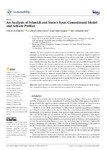Mostrar o rexistro simple do ítem
An Analysis of Schmidt and Stein’s Sport Commitment Model and Athlete Profiles
| dc.contributor.author | De Francisco, Cristina | |
| dc.contributor.author | Gómez-Guerra, Cynthia | |
| dc.contributor.author | Vales-Vázquez, Ángel | |
| dc.contributor.author | Arce, Constantino | |
| dc.date.accessioned | 2022-05-13T15:11:31Z | |
| dc.date.available | 2022-05-13T15:11:31Z | |
| dc.date.issued | 2022-02-02 | |
| dc.identifier.citation | De Francisco, C.; Gómez-Guerra, C.; Vales-Vázquez, Á.; Arce, C. An Analysis of Schmidt and Stein’s Sport Commitment Model and Athlete Profiles. Sustainability 2022, 14, 1740. https://doi.org/10.3390/su14031740 | es_ES |
| dc.identifier.issn | 2071-1050 | |
| dc.identifier.uri | http://hdl.handle.net/2183/30672 | |
| dc.description.abstract | [Abstract] The sport commitment model proposed by Schmidt and Stein is one of the most complete paradigms on the etiology of burnout syndrome. According to this model, the degree of burnout of athletes is related to the nature of their commitment to sporting activity. Based on the Benefits, Costs, Satisfaction, Alternatives, and Investments, three types of athletes are defined: (1) athletes who are fully committed because they enjoy the activity; (2) athletes who are committed because they feel trapped; (3) athletes who are not committed and are at risk of abandonment. Analysis of cluster and analysis of variance were performed using data collected from a sample of 357 athletes. The results were aligned with the Schmidt and Stein model predictions in terms of athlete type and partial scores for each component of the model, although with slight variations. The percentage of athletes correctly classified is 99.35% for the cluster of committed athletes; 97.35% for the cluster of entrapped athletes; 96.63% for the cluster of non-committed athletes at risk of abandonment. In conclusion, the sport commitment model provides a useful approach to explain the etiology of burnout in athletes, helping to understand the psychological keys to the syndrome. | es_ES |
| dc.description.sponsorship | This research was funded by Xunta de Galicia (Consolidación 2019 GPC GI-1456 Comportamiento Social y Psicometría Aplicada—COSOYPA, Consellería de Educación, Universidade e Formación Profesional), grant number ED431B 2019/0 | |
| dc.description.sponsorship | Xunta de Galicia; ED431B 2019/0 | |
| dc.language.iso | eng | es_ES |
| dc.publisher | MDPI | es_ES |
| dc.relation.uri | https://doi.org/10.3390/su14031740 | es_ES |
| dc.rights | Atribución 4.0 Internacional | es_ES |
| dc.rights.uri | http://creativecommons.org/licenses/by/4.0/ | * |
| dc.subject | Sport commitment | es_ES |
| dc.subject | Athlete burnout | es_ES |
| dc.subject | Entrapment | es_ES |
| dc.subject | Social exchange theory | es_ES |
| dc.subject | Sport Dropout | es_ES |
| dc.subject | Love-commitment theory | es_ES |
| dc.subject | Investment model | es_ES |
| dc.subject | Sport enjoyment | es_ES |
| dc.subject | Satisfaction | es_ES |
| dc.subject | Compromiso deportivo | es_ES |
| dc.subject | Esgotamento do deportista | es_ES |
| dc.subject | Atrapamento | es_ES |
| dc.subject | Teoría do intercambio social | es_ES |
| dc.subject | Abandono do deporte | es_ES |
| dc.subject | Teoría do amor-compromiso | es_ES |
| dc.subject | Modelo de investimento | es_ES |
| dc.subject | Satisfacción deportiva | es_ES |
| dc.subject | Agotamiento del deportista | es_ES |
| dc.subject | Atrapamiento | es_ES |
| dc.subject | Teoría del intercambio social | es_ES |
| dc.subject | Abandono del deporte | es_ES |
| dc.subject | Teoría del amor-compromiso | es_ES |
| dc.subject | Modelo de inversión | es_ES |
| dc.title | An Analysis of Schmidt and Stein’s Sport Commitment Model and Athlete Profiles | es_ES |
| dc.type | info:eu-repo/semantics/article | es_ES |
| dc.rights.access | info:eu-repo/semantics/openAccess | es_ES |
| UDC.journalTitle | Sustainability | es_ES |
| UDC.volume | 14 | es_ES |
| UDC.issue | 3 | es_ES |
| dc.identifier.doi | 10.3390/su14031740 |
Ficheiros no ítem
Este ítem aparece na(s) seguinte(s) colección(s)
-
GI-INCIDE - Artigos [16]






